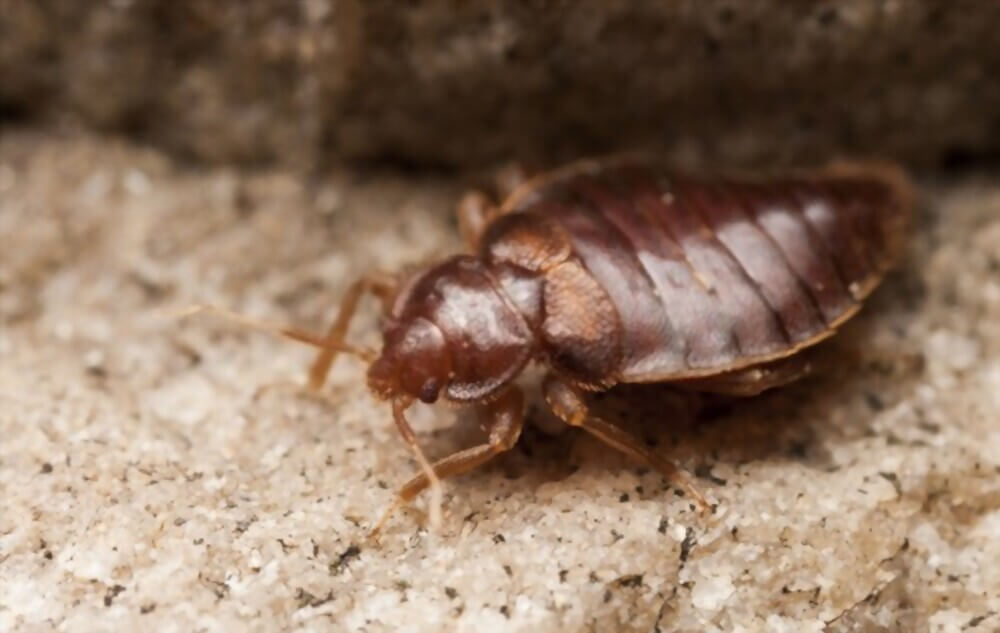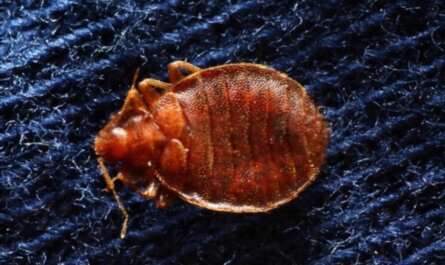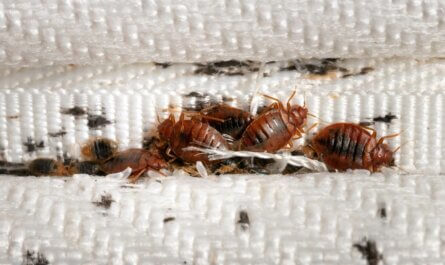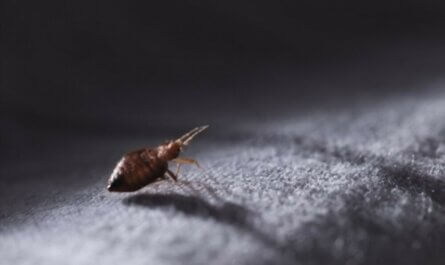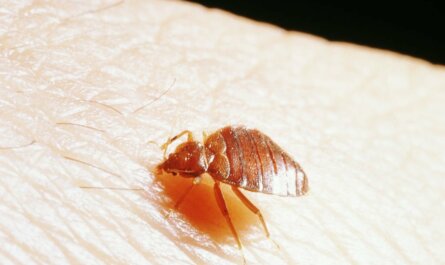Are bed bugs making your nights a nightmare? Contrary to popular belief, these annoying pests can’t fly.
In this blog post, we’ll debunk myths surrounding bed bugs and give you valuable insights on how they move around so as to better fight against their infestations.
Keep reading for clear solutions to stop these unwelcome hitchhikers right in their tracks!
Key Takeaways
- Bed bugs cannot fly. They lack the wing structure necessary for flight and instead rely on crawling and hitchhiking to move from place to place.
- These pests are expert travelers, using humans and their belongings as a free ride to new locations. They can hide in luggage, clothing, or furniture and easily infest new areas.
- Bed bug bites can cause skin irritation and itching but are usually painless. While they are primarily nocturnal creatures, they can also be active during the day if necessary for their survival.
- Signs of a bed bug infestation include blood stains on sheets, musty odors in the bedroom, dark spots of fecal matter on bedding or furniture, tiny eggs or eggshells near hiding places, and live bed bugs themselves.
- To prevent bed bugs, keep your living space clean and clutter – free, vacuum regularly especially in cracks and crevices where they may hide, use mattress covers designed to prevent infestation.
- Professional extermination is often the most effective treatment option for eradicating bed bugs. Heat treatment is another method that kills them with high temperatures. Clutter removal helps reduce hiding places while regular vacuuming is important for managing their presence.
Bed Bug Facts and Myths
Bed bugs are small, oval-shaped insects that feed on the blood of humans and animals.
Appearance and behavior of bed bugs
Bed bugs, known for their bloodsucking behavior, are ravenously drawn to warmth and carbon dioxide.
These creepy insects possess a total of six legs and two antennae but lack wings, ruling out any possibility of flight.
Bed bugs display astounding adaptability by rapidly crawling over an array of surfaces. Female bed bugs have an eerily clever habit: they lay their eggs in secluded places, making it quite challenging to spot infestations early enough before they become extensive problems.
So despite their small size and non-threatening appearance, these pests can cause significant trouble if left unchecked.
Can bed bugs fly?
Contrary to some rumors, bed bugs cannot fly. These insects lack the wing structure necessary for flight. While they might appear to move quickly when threatened, this doesn’t involve any aerial component.
This rapid movement is simply fast-paced scurrying that can reach speeds of about a meter per minute.
Resembling tiny apple seeds in size and coloration, bed bugs are efficient crawlers and skilled climbers instead.
They navigate through bedding seams, along mattress edges or within furniture crevices with relative ease — no wings necessary! Despite their inability to take flight or jump like some pests, these bloodsucking parasites have perfected ways of moving unnoticed from place to place by hitching rides on luggage or other personal items.
Their real strength lies not in flying but in remaining undetected as they gradually infest new areas.
How do bed bugs travel?
Bed bugs are skilled hitchhikers, using humans and their objects as a free ride to new locations.
They’re not just confined to beds either; these pesky pests can travel in luggage, books, clothes or furniture – anything that’s close enough for them to crawl onto.
Despite popular belief, bed bugs cannot fly; they simply have no wings.
What makes them excellent travelers is their flat body shape which allows them to squeeze into small spaces like the seams of your suitcase or inside upholstered items.
This ability also helps in hiding effectively until their next blood meal.
When introduced into a fresh environment like your home, these miniature invaders swiftly disperse and find new areas for infestation within the dwelling via cracks and crevices in walls or flooring.
On top of it all, even eggs can be accidentally transported by unsuspecting hosts undetected due to their tiny size!
Why are they called bed bugs?
Bed bugs got their name because they are attracted to warmth, blood, and carbon dioxide found in beds. Despite the name, bed bugs can be found in both clean and dirty environments.
They cannot fly, which is why they tend to infest beds where they have easy access to their preferred source of food: human blood.
This association with beds also comes from the fact that bed bugs can survive for up to a year without a meal, making mattresses and other bedding an ideal hiding place for them.
So if you’re wondering why these pests are called “bed bugs,” it’s all because of their strong affinity for our sleeping spaces.
Bed Bug Bites and Behaviors
Bed bug bites can be itchy and uncomfortable, but they are usually painless. Discover more about bed bug behaviors and where they hide to protect yourself from these pesky insects.
Do bed bug bites hurt?
Bed bug bites can cause skin irritation and itching, leading to discomfort. Although the bites are usually painless at the time of contact, they can result in redness, swelling, and a rash on the skin.
In some cases, individuals may experience an allergic reaction to bed bug bites, which can lead to more severe symptoms.
It’s important to note that welts from bed bug bites typically do not have long-term side effects and usually clear up without treatment within a week or two.
If you are experiencing persistent discomfort or an allergic reaction after being bitten by bed bugs, it is advisable to seek medical attention for proper diagnosis and treatment.
What do bed bugs do during the daytime?
Bed bugs, despite being primarily nocturnal creatures, can also be active during the daytime.
When residents work at night and sleep during the day, bed bugs adjust their behavior accordingly.
During the daytime, they may come out of hiding to feed on human blood if necessary for their survival.
It’s important to note that bed bugs are wingless and cannot fly, so they rely on crawling or hitchhiking to move around.
While they are not known to spread diseases like other insects do, some individuals may experience allergic reactions to their bites.
Where do bed bugs hide?
Bed bugs are experts at hiding and can be found in various places in your home. They tend to hide near the piping, seams, and tags of mattresses, as well as in or near bed frames, headboards, and bedding.
These sneaky pests look for perfect hiding spots like mattresses and box springs but they do not live in nests.
Keep an eye out for any signs of infestations such as dark spots on sheets or furniture or insect bites on your body.
Make sure to inspect mattress seams, box springs, headboards, and even the tags on your bedding for any crawling insects.
Identifying Bed Bugs
To identify bed bugs, look for small, reddish-brown insects about the size of an apple seed. They have flat bodies, tiny antennae, and six legs.
How to know if you have bed bugs
To determine if you have a bed bug infestation, look out for these signs:
- Bites on your skin that appear as red, itchy welts. Bed bug bites usually occur in a line or cluster.
- Bloodstains on your sheets or pillowcases. These stains can be from accidentally crushing a bed bug while you sleep.
- Musty odors in your bedroom. Bed bugs release pheromones that can give off a distinct, unpleasant smell.
- Fecal marks on your mattress or furniture. These dark spots are left behind by bed bugs after they feed.
- Shell casings and bed bug eggs. These tiny, oval – shaped shells and eggs can often be found near their hiding places.
- Live bed bugs themselves. Adult bed bugs are about the size of an apple seed and have a flat, oval – shaped body.
Common signs of a bed bug infestation
Bed bug infestations can be a real nuisance, causing discomfort and stress. If you suspect you have a bed bug problem, here are some common signs to look out for:
- Blood spots on sheets or mattress: Bed bugs feed on blood and may leave behind small reddish-brown stains on your bedding.
- Tiny pale yellow eggs or eggshells: Bed bugs reproduce quickly and lay their eggs in hidden corners of your home. Keep an eye out for tiny eggs or empty eggshells.
- Black dots of bedbug poop: Another telltale sign of a bed bug infestation is the presence of black spots on your sheets, mattresses, or even along the baseboards. This is actually their fecal matter.
- Live or dead bed bugs: Adult bed bugs are visible to the human eye and about the size of an apple seed. Look for them hiding in cracks and crevices around your bed or furniture.
- Small black spots on sheets, mattresses, or bedsprings: These dark spots are often a combination of bed bug excrement and shed skin.
- Musty odor: In extreme infestations, you may notice a sweet yet musty smell caused by large numbers of bed bugs releasing pheromones.
Preventing and Treating Bed Bugs
To prevent bed bugs, regularly inspect and clean your living space, including your mattress and furniture.
Vacuum frequently and seal any cracks or crevices where they may hide. If you suspect an infestation, contact a professional pest control company for effective treatment options.
Tips for preventing bed bugs
Prevent bed bugs from infesting your home with these helpful tips:
- Keep your living space clean and clutter – free.
- Vacuum regularly, paying attention to cracks and crevices where bed bugs could hide.
- Use mattress covers designed to prevent bed bugs from entering or escaping.
- When staying in hotels or other accommodations, inspect the room thoroughly for signs of bed bugs before unpacking.
- Avoid purchasing second – hand furniture without thoroughly examining it for signs of infestation.
- If you suspect a bed bug infestation, seek professional pest control assistance.
- Wash and dry bedding on high heat to kill any potential bed bugs or eggs.
- Be cautious when bringing used items into your home, such as clothing or furnishings, as they may harbor bed bugs.
- Store luggage and personal belongings off the floor when traveling to avoid picking up bed bugs.
Bed bug treatment options
Bed bug treatment options include:
- Professional extermination: Seek the help of a licensed pest control professional who specializes in bed bug eradication. They will conduct a thorough inspection, determine the extent of the infestation, and use appropriate insecticides to eliminate the bugs.
- Heat treatment: Bed bugs cannot survive high temperatures, so heat treatment can be effective. Professionals use special equipment to raise the temperature in infested areas to a level that kills the bugs and their eggs.
- Encasement: Mattress and box spring encasements are specially designed covers that trap any existing bed bugs inside and prevent new ones from infesting these areas. This can aid in controlling bed bug populations.
- Clutter removal: Removing clutter from your home reduces hiding places for bed bugs and makes treatment more effective. Decluttering also helps with early detection of infestations.
- Vacuuming: Regular vacuuming is an important part of bed bug management. Use a vacuum cleaner with a disposable bag or empty the bagless vacuum outside to prevent re-infestation.
- Steam treatment: High-temperature steam kills bed bugs on contact, making it an effective treatment option for furniture, mattresses, and fabric items that cannot be easily treated with insecticides.
- DIY products: There are various over-the-counter bed bug sprays and powders available that claim to kill bed bugs on contact. However, their effectiveness may vary, and they should be used as part of an integrated approach along with other treatment methods.
- Laundering infested items: Washing bedding, clothing, curtains, and other washable items in hot water followed by high-heat drying can kill bed bugs present on these items.
- Freezing: Extremely low temperatures can also kill bed bugs and their eggs. Some people choose to freeze infested items like clothing or small electronics to eliminate any hidden pests.
- Prevention measures: Taking proactive steps to prevent bed bug infestations can save you from the hassle of having to deal with them. This includes regular inspection of your surroundings, using protective covers on mattresses and box springs, and being cautious when bringing second-hand furniture into your home.
Debunking Bed Bug Myths
Many myths exist about bed bugs, including the belief that they can fly or jump.
However, bed bugs are nonflying insects and rely on crawling and hitchhiking to travel from one location to another.
Top 10 myths about bed bugs
- Bed bugs can fly and jump long distances.
- Bed bugs only infest dirty homes and hotels.
- Bed bug bites always cause severe itching and swelling.
- Bed bugs are too small to see with the naked eye.
- Bed bugs only live in beds and mattresses.
- Bed bugs only come out at night to feed.
- Bed bugs can transmit deadly diseases to humans.
- Bed bug infestations are easy to get rid of on your own.
- Bed bugs are attracted to filth and poor hygiene.
- Bed bugs can be killed by using over-the-counter pesticides.
Remember, understanding the truth about bed bugs is crucial for effective prevention and control strategies.
Seek professional help if you suspect a bed bug infestation and follow proper treatment methods to eliminate these pests from your home or property.
Can bed bugs live in the cold?
Bed bugs are known for their resilience and ability to survive in a variety of conditions, including cold temperatures.
Despite this common misconception, bed bugs have been found to endure even freezing temperatures.
They can withstand chilly environments for extended periods without feeding, sometimes surviving up to a year or more without a blood meal.
It’s important to note that while bed bugs can survive in the cold, they prefer warmer climates and are most active at temperatures between 70 and 80 degrees Fahrenheit.
So, if you’re dealing with a potential bed bug infestation, it’s crucial to consider comprehensive prevention and treatment strategies regardless of the temperature outside.
Conclusion
Understanding bed bug behavior and prevention strategies is crucial in managing and eliminating infestations.
By debunking common myths surrounding bed bugs, identifying their hiding spots, and implementing effective prevention methods, individuals can protect themselves and their homes from these persistent pests.
If faced with a severe infestation, seeking professional help is recommended to ensure complete eradication of bed bugs. Stay vigilant and take proactive measures to keep your living spaces free from these unwanted intruders.
Understanding bed bug behavior and prevention strategies
To effectively prevent and control bed bug infestations, it is crucial to understand their behavior. Bed bugs are crawling insects that can easily move from one place to another by latching onto clothing or objects.
They are experts at hiding in cracks, crevices, and the seams of mattresses, making them difficult to detect. Early detection of infestations is essential as they can go unnoticed for a long time and become large before being detected.
To prevent bed bug infestations, it’s important to practice good hygiene and cleanliness, inspect second-hand furniture thoroughly before bringing it into your home, and take necessary precautions while traveling.
Seek professional help if needed
Professional help may be necessary if you suspect a bed bug infestation in your home. Untreated infestations can lead to chronic reactions and can be difficult to eliminate without the expertise of pest control professionals.
Whether you are a homeowner, renter, landlord, or traveler, seeking professional assistance is crucial for effective bed bug treatment. Individuals with allergies or sensitivities, as well as those interested in hygiene and cleanliness, should not hesitate to reach out for help.
Even second-hand furniture buyers should consider professional inspection before bringing items into their homes. Healthcare facilities and Airbnb hosts also need to prioritize professional extermination services to ensure the safety of their guests and patients.
FAQs
Can bed bugs fly?
No, bed bugs cannot fly. They are wingless insects that rely on crawling or hitchhiking to move from place to place.
How do bed bugs travel if they can’t fly?
Bed bugs can travel by crawling and hiding in luggage, clothing, bedding, or furniture. They can also move between neighboring rooms or apartments through cracks and crevices.
Are bed bugs attracted to dirt or filth?
No, bed bugs are not attracted to dirt or filth. They are attracted to warmth and the carbon dioxide emitted by humans when they sleep.
Where do bed bugs usually hide?
Bed bugs typically hide in small cracks and crevices near their food source (humans). This includes mattresses, box springs, headboards, baseboards, furniture seams, and even electrical outlets.
How can I get rid of a bed bug infestation?
Getting rid of a bed bug infestation often requires professional help as they are resilient pests that can be difficult to eliminate completely on your own. Professional pest control treatments may include chemical sprays or heat treatments depending on the severity of the infestation.

